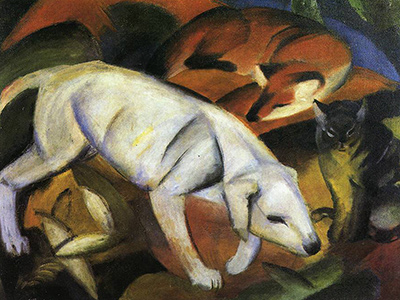Three Animals (Dog,Fox and Cat) was painted by Franz Marc (1880-1916) in 1912. Franz Marc was born in Munich, the son of a landscape painter.
Marc studied art at the Munich Academy of Fine Arts and went on to study art in France, where he was greatly influenced by the work of the Impressionist painter, Vincent Van Gogh.
Later, Marc became a leading exponent of the German Expressionist movement. In 1911, he joined with Wassily Kandinsky, August Macke and other artists to form the artistic group Der Blaue Reiter (The Blue Rider).
The values of Der Blaue Reiter emphasised emotion, intuition and spirituality over excessive formalism, taking their inspiration from early medieval and so-called 'primitive' art as well as from the earlier Impressionists.
It was in this spirit that Franz Marc composed and exhibited a series of oil paintings featuring animals, in particular, cats and dogs, of which Three Animals (Dog,Fox and Cat) is a prime example.
The use of primary colours is typical of the work of Der Blaue Reiter and is meant to convey raw emotion. For Franz Marc, each colour had its own symbolism so, for example, red is associated with the physical world, often with violence, while yellow symbolises femininity and blue evokes masculinity and spirituality.
In this picture, we can see that although the colour red is naturally emanating most strongly from the fox and the cat possesses a kind of subdued blue colouring, all three animals are surrounded by a multi-form background flooded with shades of blue, red and yellow as though all three energies are latent in each of the resting animals.
Tragically, violence overtook Franz Marc's own life at the early age of 36 when he was killed at the Battle of Verdun in 1916. The First World War put a premature end to Der Blaue Reiter movement, but its artistic influence continued to influence future generations of artists.




